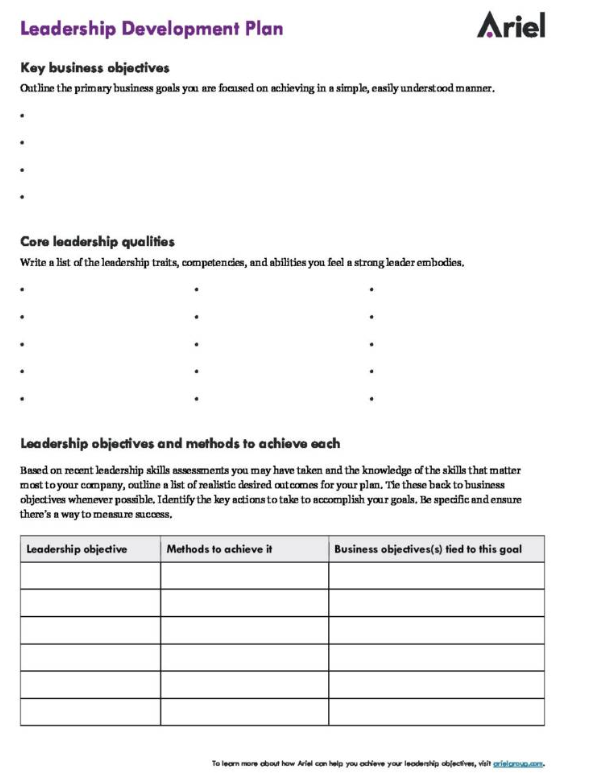Creating an Effective Leadership Development Plan

Strong senior leadership can add as much as 35% to a company’s value, according to research revealed in the Deloitte report, “The Leadership Premium: How Companies Win the Confidence of Investors.” That’s because great leaders help businesses achieve better overall organizational performance, which directly affects productivity, customer satisfaction, and the bottom line.
Perhaps this is why leadership development is a $366 billion global industry, according to TrainingIndustry.com. Savvy organizations know that to achieve business objectives their leaders must be skilled at connecting with the hearts and minds of team members and clients via a variety of formats — in-person, virtually, presentations, and written communication.
Ready to create your own leadership development plan? Identify your goals with Ariel’s Leadership Development Plan template.
What is Leadership Development?
A whopping 77% of CEOs who were surveyed for PwC’s CEO Survey Report cited being concerned that the lack of critical leadership skills would negatively impact their companies’ growth. They highlighted that leaders with emotional intelligence who are creative and innovative are the most difficult to find. This isn’t surprising when one considers that many employees get promoted because they are good at their jobs, not because they are good leaders. Suddenly, upon being promoted, they find themselves having to lead and inspire people — something they weren’t specifically trained for. This puts them at a huge disadvantage and can result in their teams being disgruntled as well as business objectives being missed. Lack of leadership skills are particularly troublesome during periods of change when confident leadership is needed in order for teams to feel secure, supported, heard, and understood.
Leadership development focuses on developing and coaching leaders at all levels in crucial leadership skills that place them, and their teams, in the best position to achieve business success.
Benefits of Leadership Development
Leadership development provides a strong competitive business advantage by:
- Enhancing financial performance. Leadership development results in key business goals being achieved.
- Attracting and retaining talent. Great leaders attract and inspire high-performing employees. Therefore, developing your best leaders is essential when it comes to attracting and retaining the best talent.
- Driving strategy execution. The most effective leadership development programs are specifically designed with a company’s business strategy in mind. Such programs serve to equip leaders with the leadership skills they need to rally employees around business initiatives and strategies.
- Improving the ability to navigate change. Harvard Business Review says the need for leadership development has never been more urgent due to today’s volatile, uncertain, and complex business environment. Leadership development empowers leaders to quickly and effectively respond to and navigate change within unpredictable business environments.
- Controlling Costs. Developing the leadership skills of existing employees is far easier, and less costly, than finding new hires with specific leadership skills.
What is a Leadership Development Plan?
In order to be highly effective in today’s unpredictable business climate, your leaders must be able to address both strategic and “human” needs within your company. A leadership development plan is designed to build key leadership qualities and competencies in your current and future leaders. It maps out specific approaches to developing leadership skills within set time frames, while never losing sight of your primary goals — to achieve key business results while retaining top talent.
6 Steps for Creating & Measuring the Success of a Leadership Development Plan
To achieve desired outcomes, your leadership development plan must be relevant for leaders in each level of your company, with the ability to meet their needs as their careers progress. This ensures they are always performing optimally. Ariel, which has been co-creating leadership development plans with our clients in a variety of industries for over 25 years, has identified six key steps for creating a leadership development plan and measuring its success.
- Home in on key business objectives. Outline the primary business goals you are focused on achieving in a simple, easily understood manner. One example could be achieving 30% improvement in closed sales in 12 months.
- Define core leadership qualities. To do so, you can write a list of the leadership traits, competencies, and abilities you feel a strong leader embodies. When complete, you can get feedback from senior leadership regarding the list in order to identify the skills that matter most to your company.
- Conduct a leadership skills assessment. Identify the specific leadership skills that need to be developed at your company in order to achieve key business objectives via a leadership skills assessment. There are many ways to perform a leadership skills assessment including speaking with leaders to find out what they feel they need to be more successful, as well as gathering insights from teams regarding their leaders. Feedback can be obtained via a variety of methods including email feedback, anonymous feedback, and face-to-face feedback.
- Develop a list of leadership development plan objectives. Using what you learned from the leadership skills assessment and your knowledge of the skills that matter most to your company, outline a list of realistic desired outcomes for your leadership development plan. Tie the outcomes to achieving business goals whenever possible.
- Identify the best methods to achieve leadership development plan objectives. Considerations when it comes to achieving leadership development plan objectives include selecting relevant content as well as the best training formats – in-person classroom, virtual classroom, self-paced asynchronous learning, one-on-one coaching, or group coaching. Many companies find it is far more efficient to bring in a third-party that specializes in leadership development since they can quickly identify relevant content and best-fit training formats as well as deliver the training.
- Measure the effectiveness of your leadership development plan: It’s important to establish concrete criteria for measuring the success of your leadership development plan. Feedback from employees regarding their progress as well as analysis of how your leaders’ departments are performing should be included. Over time, taking a look at how long leaders stay with your company and how they excel in their careers is another way to measure success.
To help ensure enthusiastic company-wide acceptance of your leadership development plan, it’s a good idea to create a culture of leadership at your company. This lets every employee know they are supported to grow as a leader and will result in their feeling more enthusiastic about their work and your company.
Top Skills That Leadership Development Plans Target
According to a survey of 1,500 professionals in the learning and development industry by the Human Capital Media Research & Advisory Group, the research and advisory arm of Chief Learning Officer magazine, the importance of certain leadership skills varies depending on leaders’ roles.
The following lists highlight which leadership skills the survey participants felt were the most crucial for two groups — executives and managers. Each list begins with the skill that was ranked as being the most important.
Leadership Development Skills for Executives*
- Strategic planning
- Business acumen
- Business intelligence
- Leading innovation
- Coaching
* Source: Human Capital Media Research & Advisory Group
Leadership Development Skills for Managers*
- Coaching
- Communication – verbal, written, and nonverbal
- Employee engagement
- Business acumen
- Critical thinking
* Source: Human Capital Media Research & Advisory Group
Effective leadership development plans successfully address the skills above as well as:
- Problem-solving skills
- Conflict resolution
- Leadership skills
- Emotional Intelligence
- Teamwork
- Adaptability
- Change management
What to Look for in a Leadership Development Partner
While some companies attempt to implement a leadership development plan on their own, most realize that doing so is a daunting task. This is particularly true for companies consisting of many different business units or departments, each with its own unique training and development needs, or those that have hundreds or thousands of employees to train, perhaps all over the country or world. It’s for this reason that organizations tend to utilize the expertise of a third-party partner who specializes in leadership development that can scale with their growth.
When it comes to selecting a leadership development partner, you have a myriad of options to choose from. It’s essential to ensure that the partner you select has a proven track record regarding the following:
- Service. Your leadership development partner should have an excellent reputation, with references who are happy to speak with you about their experience. They should also be easy to communicate with — promptly answering your questions and listening carefully.
- Content. The content of your partner’s leadership development program offerings should be engaging, memorable, and tailored to your specific needs.
- Facilitators: The facilitators your leadership development partner utilizes should be inspiring experts in the subject matter they are teaching, have experience working in corporate environments, and be seasoned presenters.
- Delivery. It is essential that the delivery of the leadership training programs within your leadership development plan is effective. Sometimes you may want a larger group to participate in an in-person training session for half a day, other times you may want team members to learn online at their own pace, or you may want a specific team member to have one-on-one coaching. It’s important that your leadership development partner offer self-paced asynchronous digital, one-on-one coaching, group training, and follow-up call training options so each of your needs can be easily met.
- Global reach. If you have corporate locations throughout the United States or internationally, it’s essential that your leadership development partner be able to train your leaders wherever they are located.
Gain a Competitive Edge
According to a study by Harvard University, 85% of executives who participated in leadership development programs improved their leadership effectiveness.
Ariel gives the organizations we work with a strong competitive edge by co-creating focused leadership development plans that can be smoothly implemented in-house. Over 1,000 companies can attest to the effectiveness of our leadership development approach, which has helped more than 15,000 business people to hone their leadership skills.
The content we utilize in the leadership development plans we help to shape, is either deeply tailored co-created content or content from our existing experiential leadership programs that can easily be tweaked to meet specific length and delivery format needs.
Reach out today to start a conversation about creating a highly effective leadership development plan that will help secure a bright future for your company.
